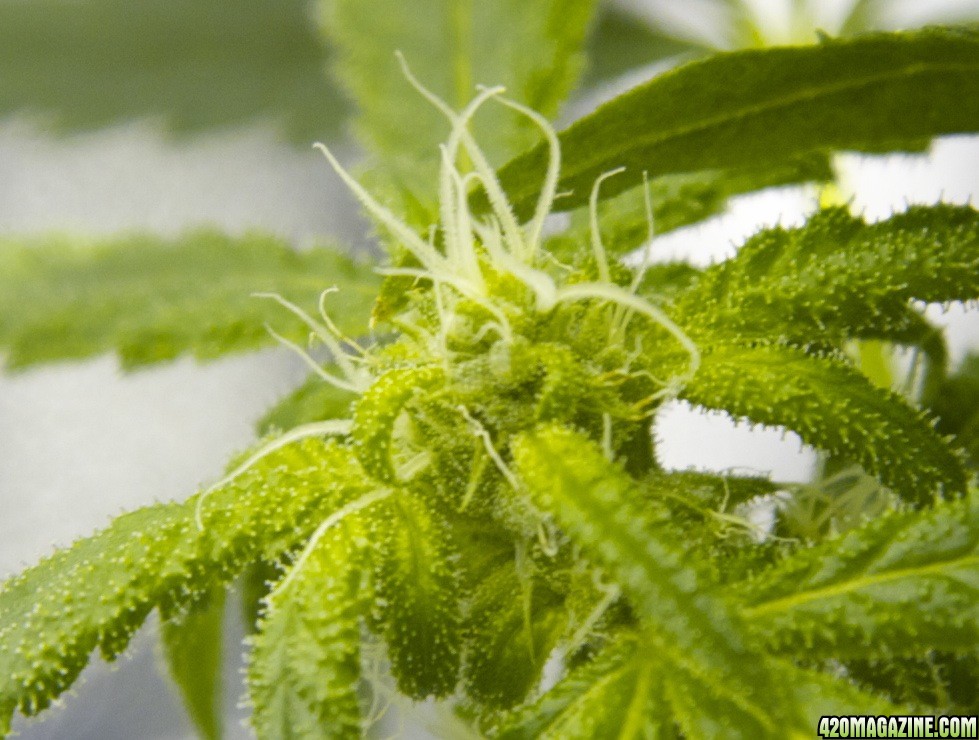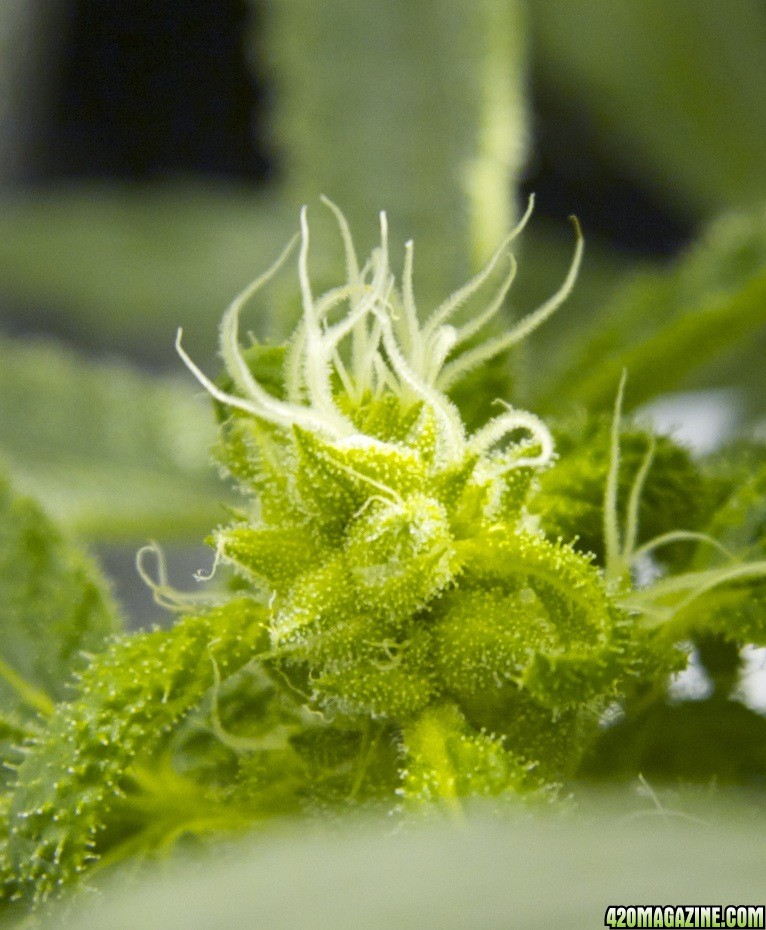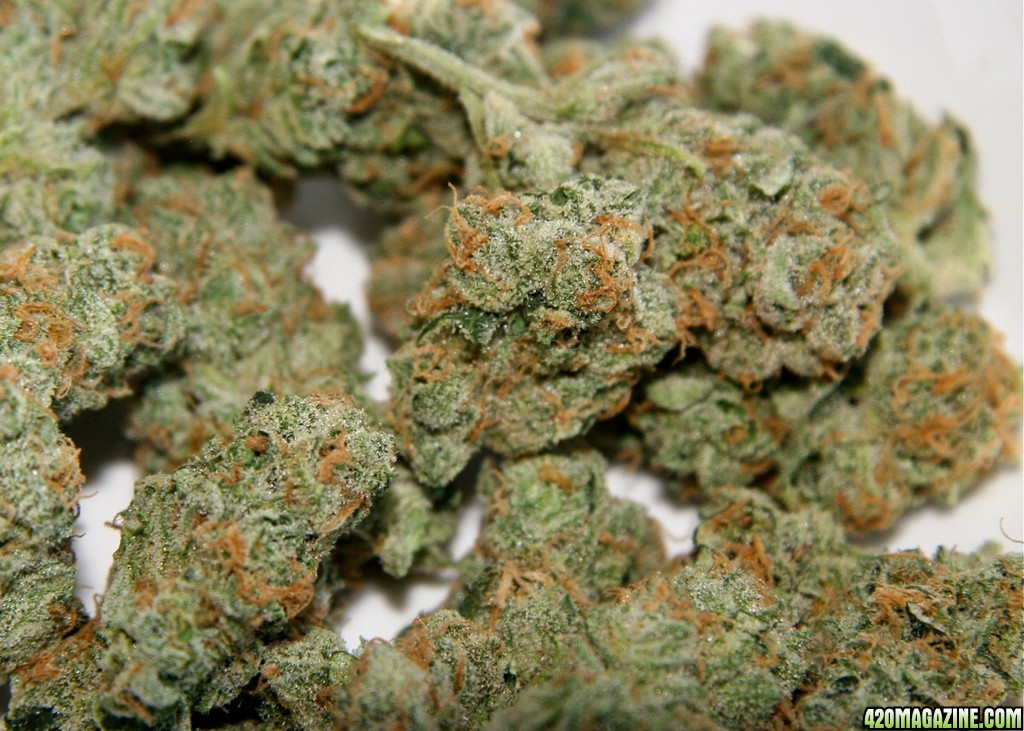A while back, I decided to harvest some pollen from a male "Jack the Ripper" plant I had, and selectively pollenate a bud on a couple of different plants. I thought I'd share the process I used, in case it helps someone else out.
First, it's advisable to read up a bit on genetics to understand a bit more about which strains are best to cross with one another, etc. Success will be much more easily attained if the 2 strains are genetically diverse from one another. Pure, or landrace, strains are best. Indicas cross well with sativas - basically, you want genetic diversity to prevent recessive genes from ruining the outcome. Again, some reading up is prudent in this regard... Think of humans - cousins, brothers, sisters... shouldn't cross, or problems may occur. Same goes for plants (though advanced breeding takes advantage of these anomalies, but that's another topic...).
It should be noted that when 2 strains that are genetically diverse are crossed, the offspring may have what is called hybrid vigor. Hybrid vigor means they grow faster/more vigorously, they are more resistant to diseases, and problems - and will probably even yield a bit better. So the seeds you get from a properly done selective pollination should be very good seeds, indeed.
Okay, here's how I did it:
I had a spare room, unconnected and with no shared ventilation to the females. I set up a 4 bulb T5 lamp directly over it and threw it on a timer 12/12. I made sure that I always watered/fed it last thing before bedtime, and never went into the room with the females after visiting the male.
At about day 21 or so of bloom for the male and the females in separate room, I set some little glass bowls underneath some of the male flowers. The next day, some of the male flowers had dropped their pollen into the glass bowls. Day 21-28 is a good timeframe, as the females are ready for the pollen, and it gives them just the right amount of time for seeds to mature before harvest (takes about 35 days for seeds to mature).
I shut off all ventilation where the females were so there would be no fans to blow pollen, etc (This is very important!!)
I very carefully carried the pollen bowl, with a q-tip also in hand to where the females were. I pollinated one small bud on 3 different plants by very carefully painting pollen on the bud with the q-tip, being super careful not to spill or drop any on other parts of the plant or the floor, etc. I then removed the pollen bowl and q-tip to a safe location away from the plants.
Then, I took a damp rag (water kills pollen) and wiped the floors thoroughly under where I pollinated the buds.
Pollination occurs almost instantaneously. Within seconds/minutes. The moment you touch the pollen to the pistils/bud, it's essentially pollinated and can't be reversed. There is a lot of misinformation out there on this, saying you need to wait 30 minutes, put a bag over the branch overnight, bla bla bla. Not true. It's pretty instantaneous, though I did wait about 10-15 minutes to be sure.
Now this next step is usually done differently, but I took a little shortcut: Once the pollen is on the buds, the common thing to do is to spray the whole plant(s) down thoroughly with water, to keep stray pollen from blowing around and pollinating other buds. Water everywhere (to deactivate any stray pollen)... Because I was very careful and thorough, I took a shortcut to this and just sprayed down the buds with water that were pollinated. Again, they are already pollinated, so the water just keeps any stray pollen from blowing around to other parts of the plant. I gambled that I didn't get stray pollen anywhere else (as mentioned I did wipe the floor down under the buds that were pollinated too).
It worked great and I managed to keep pollination to just the intended buds.I also took a little twisty tie, and tied it just below the bud I pollinated around the branch so I wouldn't forget which bud was pollinated.So, I carefully painted the buds, waited 10-15 minutes, then sprayed the bud down thoroughly with water until it dripped off. Then, I turned the fans and ventilation back on, end of process.
In the end, I ended up with between around 15-30 seeds per plant, just from the single small bud, lower on the plant. After about a week, you can already see significantly more swelling on the buds that were pollinated, and they just look a bit different and plumper. Within a couple of days, you see pistils dying and withering on the buds that were pollinated.
Here's a bud less than a week after pollination. If you look close, you can already see it swelling some. Notice I didn't use large buds, and they were low on the plant. Also, withering pistils indicate it was successfully pollinated:

Same bud about 5 days later. More swollen calyx's:

What did I do with the seeds I created? Well, I just finished harvesting 2 plants that were from this experiment. One was an OG Kush female that was pollinated, and the other was a Deadhead OG. Both were pollinated by pollen from a Jack the Ripper male I had from some regular seeds (I know you've been following my journal, so you probably knew all this).
Would I do it again? Absolutely. Worked great and produced 2 great unique crosses (I call them "Deadhead Ripper" and "OG Ripper").
These are some buds from Deadhead Ripper (Deadhead OG x Jack the Ripper). One of the reasons I liked this cross, is the 2 strains involved were both SUPER resinous. I hoped for some equally, if not more, frosty offspring - and wasn't disappointed!:

First, it's advisable to read up a bit on genetics to understand a bit more about which strains are best to cross with one another, etc. Success will be much more easily attained if the 2 strains are genetically diverse from one another. Pure, or landrace, strains are best. Indicas cross well with sativas - basically, you want genetic diversity to prevent recessive genes from ruining the outcome. Again, some reading up is prudent in this regard... Think of humans - cousins, brothers, sisters... shouldn't cross, or problems may occur. Same goes for plants (though advanced breeding takes advantage of these anomalies, but that's another topic...).
It should be noted that when 2 strains that are genetically diverse are crossed, the offspring may have what is called hybrid vigor. Hybrid vigor means they grow faster/more vigorously, they are more resistant to diseases, and problems - and will probably even yield a bit better. So the seeds you get from a properly done selective pollination should be very good seeds, indeed.
Okay, here's how I did it:
I had a spare room, unconnected and with no shared ventilation to the females. I set up a 4 bulb T5 lamp directly over it and threw it on a timer 12/12. I made sure that I always watered/fed it last thing before bedtime, and never went into the room with the females after visiting the male.
At about day 21 or so of bloom for the male and the females in separate room, I set some little glass bowls underneath some of the male flowers. The next day, some of the male flowers had dropped their pollen into the glass bowls. Day 21-28 is a good timeframe, as the females are ready for the pollen, and it gives them just the right amount of time for seeds to mature before harvest (takes about 35 days for seeds to mature).
I shut off all ventilation where the females were so there would be no fans to blow pollen, etc (This is very important!!)
I very carefully carried the pollen bowl, with a q-tip also in hand to where the females were. I pollinated one small bud on 3 different plants by very carefully painting pollen on the bud with the q-tip, being super careful not to spill or drop any on other parts of the plant or the floor, etc. I then removed the pollen bowl and q-tip to a safe location away from the plants.
Then, I took a damp rag (water kills pollen) and wiped the floors thoroughly under where I pollinated the buds.
Pollination occurs almost instantaneously. Within seconds/minutes. The moment you touch the pollen to the pistils/bud, it's essentially pollinated and can't be reversed. There is a lot of misinformation out there on this, saying you need to wait 30 minutes, put a bag over the branch overnight, bla bla bla. Not true. It's pretty instantaneous, though I did wait about 10-15 minutes to be sure.
Now this next step is usually done differently, but I took a little shortcut: Once the pollen is on the buds, the common thing to do is to spray the whole plant(s) down thoroughly with water, to keep stray pollen from blowing around and pollinating other buds. Water everywhere (to deactivate any stray pollen)... Because I was very careful and thorough, I took a shortcut to this and just sprayed down the buds with water that were pollinated. Again, they are already pollinated, so the water just keeps any stray pollen from blowing around to other parts of the plant. I gambled that I didn't get stray pollen anywhere else (as mentioned I did wipe the floor down under the buds that were pollinated too).
It worked great and I managed to keep pollination to just the intended buds.I also took a little twisty tie, and tied it just below the bud I pollinated around the branch so I wouldn't forget which bud was pollinated.So, I carefully painted the buds, waited 10-15 minutes, then sprayed the bud down thoroughly with water until it dripped off. Then, I turned the fans and ventilation back on, end of process.
In the end, I ended up with between around 15-30 seeds per plant, just from the single small bud, lower on the plant. After about a week, you can already see significantly more swelling on the buds that were pollinated, and they just look a bit different and plumper. Within a couple of days, you see pistils dying and withering on the buds that were pollinated.
Here's a bud less than a week after pollination. If you look close, you can already see it swelling some. Notice I didn't use large buds, and they were low on the plant. Also, withering pistils indicate it was successfully pollinated:

Same bud about 5 days later. More swollen calyx's:

What did I do with the seeds I created? Well, I just finished harvesting 2 plants that were from this experiment. One was an OG Kush female that was pollinated, and the other was a Deadhead OG. Both were pollinated by pollen from a Jack the Ripper male I had from some regular seeds (I know you've been following my journal, so you probably knew all this).
Would I do it again? Absolutely. Worked great and produced 2 great unique crosses (I call them "Deadhead Ripper" and "OG Ripper").
These are some buds from Deadhead Ripper (Deadhead OG x Jack the Ripper). One of the reasons I liked this cross, is the 2 strains involved were both SUPER resinous. I hoped for some equally, if not more, frosty offspring - and wasn't disappointed!:





